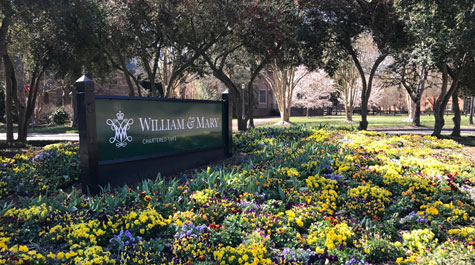W&M to establish Studio for Teaching & Learning Innovation
William & Mary will establish a Studio for Teaching & Learning Innovation at the start of the 2019-20 academic year.
An advisory team has been working on the charge from Provost Michael R. Halleran to explore establishing the center since August. The group has submitted its final report with recommendations to Halleran, and he is preparing to set up the center’s initial structure.
“We’re a university that is very proud of our commitment to teaching and our students’ learning,” Halleran said. “Establishing this studio will allow us to pull together the good ideas, the energy, around what is the fundamental activity of our university, which is teaching students in the rich variety of fields that comprise the liberal arts and sciences.
“This is the core mission of the university; we’re very good at it. This will make us even better in terms of innovation, improvement and sharing ideas. We are a stark outlier among our peers in not having such a locus of activity.”
The initiative is championed by W&M President Katherine A. Rowe, who said that faculty members have expressed a strong desire to break through disciplinary silos, adopt appropriate new technologies and more strongly unite with colleagues across the campus and schools to advance teaching excellence.
“I anticipate the Studio for Teaching & Learning Innovation will mirror the dynamism of the world into which students are graduating,” she said, “a world valuing collaboration, teamwork and diverse modes of teaching and learning. We’re very excited to see the fruits of this labor.”
The report outlines various recommendations and suggestions for the Studio’s work and affiliations.
“The establishment of an integrated Studio for Teaching & Learning Innovation would serve to coordinate existing initiatives devoted to teaching effectiveness while creating new opportunities to ignite and incubate innovative ideas and approaches, and to showcase these at our institution and beyond,” the report said.
“Creating the Studio for Teaching & Learning Innovation ('Studio') would be a concrete step toward advancing W&M priorities — among them cultivating institution-wide thinking; fostering innovation; enhancing diversity, inclusion, and equity; and building community.”
Faculty members have been expressing their desire for a hub to collaborate with one another in new ways and for support to explore new modes of learning, according to Ann Marie Stock, vice provost for academic and faculty affairs and co-chair of the Studio’s advisory team.
“There are so many reasons why faculty and staff learning partners have wanted some space where they could collaborate outside of their home discipline and outside of their home school,” Stock said. “The Studio will allow us to team up to offer more robust programming that will be available to more people. It will enable us to do a better job of identifying and maximizing synergies with existing initiatives, and developing new ones to foster innovative practices and make those more visible at W&M and beyond.”
The Studio is positioned to help the university continue to foster institution-wide thinking, which Rowe has emphasized, Stock said.
“Never before have our students’ learning needs been changing as quickly and dramatically as they are now,” Stock said. “And so I think it’s really important for faculty at all stages of their careers and also staff learning partners to be empowered and equipped to meet the changing learning needs of our students.”
Halleran will conduct an internal search among current faculty for a director for the Studio, and will set up an advisory board for it. The eLearning Initiatives group will be integrated into the Studio, according to Halleran.
Plans are for the Studio eventually to be located in the Swem Library ground floor. The renovation of this space, which has received Board of Visitors approval, is awaiting state funding. Swem was chosen because of its centrality on the campus and its importance as an intellectual hub, as well as access to Swem’s Reeder Media Center and library staff who will serve as learning partners.
“Now, we are establishing a fundamental structure; it will evolve,” Halleran said.
Carrie Cooper, dean of university libraries and a member of the Studio’s advisory team, emphasized that from the early planning stages, the library understood it had an obligation and opportunity to create community and bring faculty, and those who support teaching and learning, together.
"Librarians and archivists at William & Mary are instructional partners — we are our best when we are working hand in hand to incorporate collections and digital literacy skills into coursework and research," Cooper said. "The evolution of our library facilities to include a space dedicated to teaching and learning is a deliberate step that strengthens our community and ensures that the Earl Gregg Swem Library remains central to the student and faculty experience at William & Mary."
Gene Roche, executive professor of education currently on assignment with W&M Libraries and a member of the advisory team for the Studio, said that such university centers have become the norm in higher education.
“Our research found that most universities have some formal structure to provide support services for graduate students and faculty, generally in centers for teaching and learning,” Roche said. “In the last decade, many of those units have evolved to bring the entire educational community — students, staff and faculty — in an integrated approach to advance student success in a rapidly changing world. I see the Studio as a place that fosters that kind of diverse community where everyone is engaged in lifelong learning.”















